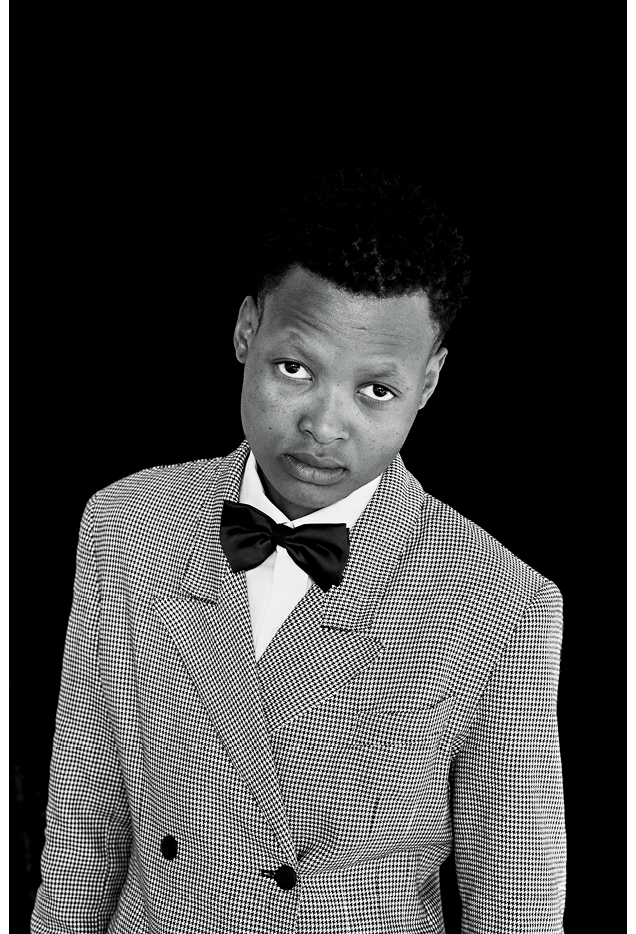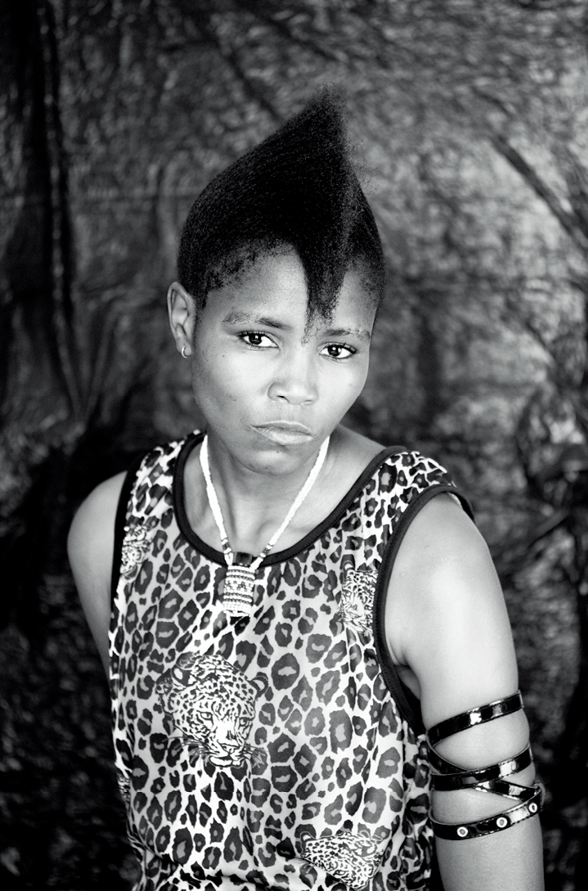
Zodwa, Paris, 2014. Gelatin silver print. Image and paper: 35½ x 23⅛ inches.
RENÉE MUSSAI AND ZANELE MUHOLI
Somnyama Ngonyama x Faces and Phases
Letter II: The Courage That Fuels Your Counter-Archival Impulse
Dear Muholi:
For you, photography is “not a luxury,” to borrow your own words, if I may, echoing those of Audre Lorde, or casual leisure-for-pleasure, but a burning necessity: a mode of survival, a suturing, a “weapon to fight back.”
After a decade of tirelessly documenting Black LGTBQIA+ individuals in South Africa and beyond, you invite us to “Hail the Dark Lioness” in Somnyama Ngonyama, the intimate visual memoir in which you are both image-maker and protagonist, merging politics with aesthetics, private and public spheres, in new and confounding ways…driven by the same counter-archival impulse that had previously fueled the creation of Faces and Phases’ living archive of Black lesbian, gender non-conforming, or bisexual women and transmen.
In this growing archive of the self, you forge a new genre of decolonial, socially engaged auto-portraiture, each photographic frame posing critical questions about social (in)justices, human rights, and contested representations of the Black body, with a stance that is at once personal and political.
A visionary mosaic of identities, an exquisite empire of selves: affirmation and reclamation, refusal and perusal, unapologetic in your artistry, unafraid in an open(ended) dialogue with the image archive—past and present…a visually seductive call to arms, a protective mantle, occupation, manifesto, and invitation: All of your portraits are, essentially, about courage—the courage to exist, the courage to resist, the courage to insist, and to persist, the courage to see, to be, to be seen, to step in front of the camera, to “face” yourself.
Pointing both inward and outward, both series constitute radical acts of inscription: inscribing your community, and yourself, into history—defiantly executing a demand for justice and visibility: “to be counted in [South African] history, to claim full citizenship,” as you have said many times.
Again and again, you strategically deploy photography as a decolonizing tool to produce visual evidence en masse, picturing your participants as human beings worthy of recognition, as courageous history-makers and cultural producers…defying dominant portrayals as vilified “others,” forgotten victims of hate crime, or disenfranchised members of a subordinate subculture in a post-apartheid South Africa that too often, still, refuses to see them.
At the core of your cultural activism—Somnyama Ngonyama as well as Faces and Phases—is the blueprint for what I think of as “remedial visual practice”: seeing differently with a commitment to care, to “imagine otherwise, to counter abandonment, to try to look, to try to really see.”1
And collectively, these portraits also serve as invaluable reminders of the critical importance of extending curative care to ourselves because caring for the self “is not self-indulgence, it is self-preservation, and that is an act of political warfare.”2
To move toward Black futurity—to bathe in “the warm illumination of a horizon imbued with potentiality,”3 requires profound courage born from a yearning that propels us forward…the kind of courage that you unwaveringly exhibit through continual inscription of radical emergent queer subjectivities, and through your beautiful, and necessary, preoccupation with putting the self in the frame: impassionedly, triumphantly, transgressively.
With gratitude and admiration
Yours, always
Renée
All quoted material by Zanele Muholi

Zodwa, Paris, 2014. Gelatin silver print. Image and paper: 35½ x 23⅛ inches.

Bona, Charlottesville, 2015. Gelatin silver print. Image: 31¼ x 20 inches. Paper: 35¼ x 24 inches.
“I’m reclaiming my blackness, which I feel is continuously performed by the privileged other. My reality is that I do not mimic being black; it is my skin, and the experience of being black is deeply entrenched in me. Just like our ancestors, we live as black people 365 days a year, and we should speak without fear.”

Ntozakhe II, Parktown, 2016. Gelatin silver print. Image: 39½ x 28¼ inches. Paper: 43½ x 32¼ inches.
“As photographers, we get carried away; we tend to focus on other people and forget about ourselves. I have made the choice to expose myself because I felt that nobody could do it for me. In order for me to remember me, and also to be remembered […] finding that moment of tranquility where you connect with yourself. Just that moment, where anything is possible. You hold up the mirror to yourself. How else would you remember that you were there?”

Sinenhlanhla Lunga, Kwanele South, Katlehong, Johannesburg, 2012. Gelatin silver print. Image: 30 x 20 inches. Paper: 34½ x 24 inches.
“For me, photography is not a luxury, but visual activism. It’s important to mark, map, and preserve our mo(ve)ments through visual histories for reference and posterity so that future generations will know that we were here…to (re)write a black queer and trans visual history of South Africa: for the world to know of our resistance and existence at the height of hate crimes in South Africa and beyond.”

Bester IV, Mayotte, 2015. Gelatin silver print. Image: 31¼ x 22½ inches. Paper: 33 x 24 inches.
“It’s a painful and difficult archive to create, a painful history to write, to make visible. I’m visualizing our lived experiences, combating and filling these gaps of silence and erasure by addressing absence through participatory image-making: introducing other ways of being, seeing and being seen—to instill pride in who we are, and what we represent, despite the dangers we face as a community. My life is about our collective lives; it’s autobiographical, it’s biographical; it’s about the lives of black LGBTQIA+ individuals, especially human beings who I love, and care for deeply.”

Vuyelwa “Vuvu” Makubetse, Parktown, Johannesburg, 2016. Gelatin silver print. Image: 30 x 20 inches. Paper: 34½ x 24 inches.

Thuleleni, Biljmer, 2017. Gelatin silver print. Image and paper: 27½ x 22¼ inches.
“Hence I am producing this photographic document to encourage individuals in my community to be brave enough to occupy spaces—brave enough to create without fear of being vilified, brave enough to take on that visual text, those visual narratives. To teach people about our history, to rethink what history is all about, to reclaim it for ourselves—to encourage people to use artistic tools such as cameras as weapons to fight back.”

Thembela Dick, Vredehoek, Cape Town, 2012. Gelatin silver print. Image: 30 x 20 inches. Paper: 34½ x 24 inches.
“What was initially a visual project became the creation of an unprecedented archive of photographs for my community and our country. I wanted to fill a gap in South Africa’s visual history that, even 10 years after the fall of apartheid, wholly excluded our very existence. However, as I began to photograph friends, comrades, neighbours, the lovers of lovers, I became curious. I asked questions and looked into the eyes of black lesbian mothers, sisters, daughters and sons, wives and husbands. I was invited into their lives and I learned of their individual joys, hopes, longings, scars, suffering, and endless love.”

Mbali Zulu, KwaThema, Springs, Johannesburg 2010. Gelatin silver print. Image: 30 x 20 inches. Paper: 34½ x 24 inches.

Lebo Leptie Phume, KwaThema, Springs, Johannesburg, 2016. Gelatin silver print. Image: 30 x 20 inches. Paper: 34½ x 24 inches.
“Faces and Phases is an insider’s perspective that both commemorates and celebrates the lives of the black queers I have met in my journeys…Faces express the person, and Phases signify the transition from one stage of sexuality or gender expression and experience to another. Faces is also about the face-to-face confrontation between myself as the photographer/activist and the many lesbians, women and trans(wo)men I have interacted with from different places.”

Lungile Cleo Dladla, KwaThema Community Hall, Springs, Johannesburg, 2011. Gelatin silver print. Image: 30 x 20 inches. Paper: 34½ x 24 inches.
“For the longest time I have reflected on absence: the absence of recognition of our black queer identities; the absence or lack of visual and textual representation of queer lives; the absence of queer voices in the articulation of contemporary arts; the absence of queer representation in post-apartheid citizenship. Absence, for me, is an active process of silencing, one that condones and facilitates the ongoing violence against women’s bodies in general, and the bodies of black queer (wo)men in particular. Specifically, the silences are those who openly identify as LGBTI persons…I not only reflect on absence, but also attempt to imagine different futures, different ways of thinking about our lived experiences, other ways of being, seeing and being seen.”

Ayanda Magoloza, Kwanele South, Katlehong, Johannesburg, 2012. Gelatin silver print. Image: 30 x 20 inches. Paper: 34½ x 24 inches.
“The most important task is to create a visual archive that lives on beyond us. I see these projects as a visual document in which we create our own kind, where we bring forth our own narratives.”

Somnyama Ngonyama II, Oslo, 2015. Gelatin silver print. Image and paper: 21¼ x 18½ inches.
All images by Zanele Muholi. © Zanele Muholi, courtesy of the artist, Yancey Richardson, New York, and Stevenson Cape Town / Johannesburg
“It is our responsibility as activists and artists—as activists who practice art—to challenge all ‘isms,’ starting with racism. To combat bias and erasure. To keep the dialogue going and create opportunities for others less fortunate or privileged. To open access to spaces historically denied to us—to black, queer, trans, female-bodied, and gender-nonconforming individuals, especially. That is my main agenda going forward: to queer-ize, to blacken, to open, and to occupy spaces.” —Zanele Muholi
1. Sharpe, Christina. In the Wake: On Blackness and Being (Durham, NC, and London: Duke University Press, 2016).
2. Lorde, Audre. Your Silence Will Not Protect You (London: Silver Press, 2017).
3. Muñoz, José Esteban. Cruising Utopia: The Then and There of Queer Futurity (New York: New York University Press, 2009).
MUSSAI, MUHOLI